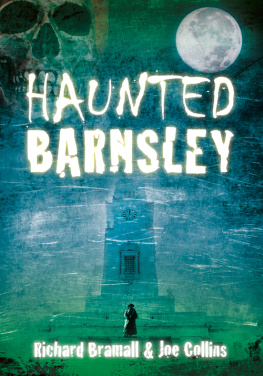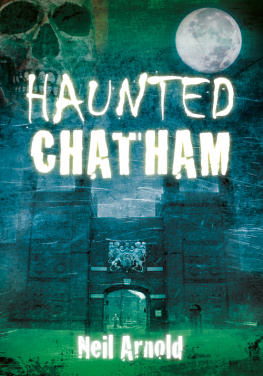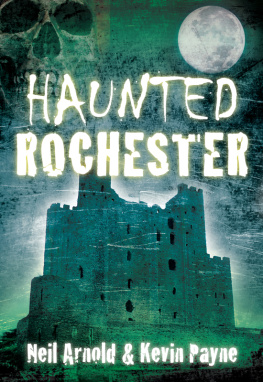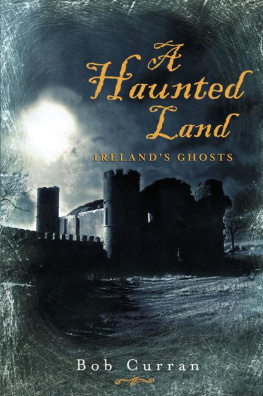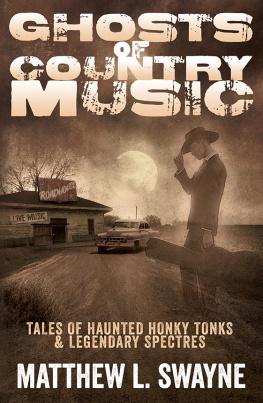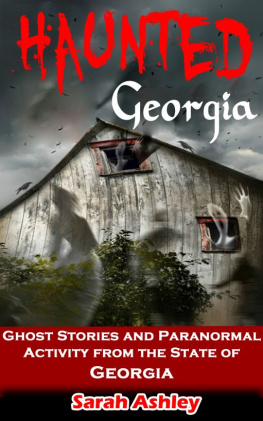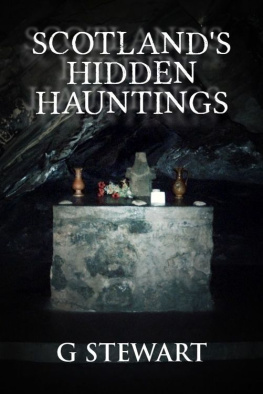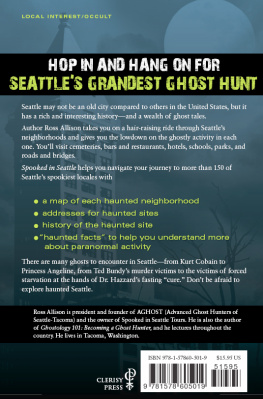
We would like to dedicate this book to the good people of Barnsley, our long-suffering wives who put up with many late nights while we wrote it, and all the friends who we dragged along in the freezing cold on our ghost hunts over the years. Also, our warmest thanks and deepest respect must go to the departed souls who returned from the dead and kept us up late into the night. Without all of your help, there would be no book to write.
We would like to thank the following people and organisations for their contributions to this book: Judy King; Andy Beecroft; Barnsley Central Library; Heidi Cook; Carol Moore; Jan Harris; Leeanne Clegg; Graham Hawks; Chris Hepple; Yorkshire Times ; Steve Sylvester from Hoyland Lowe Stand Trust; the Tudor family; Graham Noble; and Jim Lightfoot.

Richard Bramall and Joe Collins.
Contents
one |
two |
three |
four |
five |
six |
seven |
eight |
nine |
ten |
eleven |
twelve |
thirteen |
fourteen |
fifteen |
sixteen |
seventeen |
eighteen |
nineteen |
twenty |
twenty-one |
twenty-two |
twenty-three |
twenty-four |
twenty-five |
twenty-six |
twenty-seven |
twenty-eight |
twenty-nine |
The British Isles are arguably amongst the most haunted locations in the world, and Barnsley plays its part in this. Over the years, we have amassed a vast amount of knowledge and experience on the reported hauntings around Barnsley and where better to share it all than in a book, which people can refer to in years to come. Contained herein are some of the reported sightings and stories from ordinary people who believe that they have had an extraordinary experience. This book is aimed at everyone interested in the legions of phantoms that inhabit Barnsleys homes, pubs and highways.
When we ask people if they believe in ghosts, we are often greeted by one of the following replies: Theres no such thing!, Theres something, but I dont know what! or Yes, I have seen one! People who have witnessed ghosts, and especially those who have been involved with demonic cases, are not always quick to reveal their true beliefs. They often feel embarrassment, humiliation or even guilt.
Unfortunately, we live in a society that seems to ridicule and dismiss paranormal reports. Some large organisations do not want the public to be privy to information on hauntings at their premises. Nor do some individuals want their best friends and closest relatives to know of their experiences sometimes going to great lengths to cover up their encounters. We are putting a number of these accounts in print, though names and locations have been changed in order to protect identities.
Richard Bramall and Joe Collins, 2012
The South Yorkshire town of Barnsley lies on the River Dearne. It is surrounded by several smaller settlements, which together form the Metropolitan Borough of Barnsley. Barnsley is notable as a former industrial town, centred on coal mining and glass making; a few factories still remain, notably the glassworks and coking plant. Though these industries declined in the twentieth century, Barnsleys local culture remains rooted in its industrial heritage.
The first historical reference to the town occurs in 1086 in the Domesday Book, in which it is called Berneslai, with a total population of around 200. The exact origin of the name Barnsley is still subject to debate, but Barnsley Council claims that its roots lie in the Saxon word Berne (for barn or storehouse) and Lay (for field). The original town (in the parish of Silkstone) developed little until the 1150s, when it was given to the monastery of St John, Pontefract. The monks decided to build a new town where three roads met: the Sheffield to Wakefield, Rotherham to Huddersfield, and Cheshire to Doncaster routes. The Domesday village became known as Old Barnsley, and a town grew up on the new site.
From the seventeenth century, Barnsley developed into a stop-off point on the route to Leeds, Wakefield, Sheffield and London. Traffic was generated as a result of this, causing hostelries and related services to prosper. Barnsley grew into an important manufacturing town and was a principal centre for linen weaving during the eighteenth and nineteenth centuries. However, it is most famous for its coalfields. All the pits have now closed, but the busy market town continues to thrive.

one
Rockleigh Furnace
Numerous strange phenomena have been witnessed at the furnace over the years. Notably, a man who was walking his dog late one evening saw light from the fiery furnace burning brightly through the trees. Walking over to take a closer look, he saw a blacksmith dressed in leather overalls, busy about his work. The smith did not acknowledge the man, he just carried on his business. Suddenly, there was a large blast from the furnace and a bright white flash caused the man to shield his eyes for a second. When he opened them again, the scene had disappeared and all that was left was the empty ruin of the furnace.

Rockleigh furnace, when it was in use in the eighteenth century. (Authors collection)

The Engine House, where the sound of a disembodied scream is heard. (Authors collection)
The engine house is also said to be the epicentre of strange phenomena; supernatural lights have been seen encircling the building, and ear-piercing screams have been heard echoing throughout the woods. The sounds emanate from the bowels of the tower, where a child is said to have fallen after playing there. One brave motorist went to investigate the lights one evening, after seeing them from the roadside, but as he moved through the trees the lights vanished and a deathly silence fell about the area. As he approached the tower, he couldnt shake off the eerie feeling of being observed from a distance he quickly returned to his car.
two
Railway Line in Carlton
Carlton railway line opened in 1885 and stretched for a total of 66 miles; its name was changed in 1905 to the Hull & Barnsley Railway, even though the line never entered into Barnsley (it finished at Stairfoot). Today, the line is closed and people walk along the old tracks.
A woman out walking her dog on a crisp and frosty New Years morning noticed another woman approaching. As they drew level, she saw that it was an elderly lady dressed in an old knitted shawl, clasping it tightly to shelter herself from the wind. The walker thought this was a little odd, due to the ladys advanced years and the remote location, but greeted the lady with a friendly Good morning. The old woman returned the gesture with a kind smile, but the dog wasnt too pleased to see the old woman and dropped to the floor, cowering and crying. A little embarrassed by the dogs actions, the walker looked up at the old lady, whose smile had now changed into a sadistic and knowing grin. At that moment the woman started to fade, and disappeared right before her eyes. The dog walker still visits the area often, but has never seen the old woman again.
Next page
